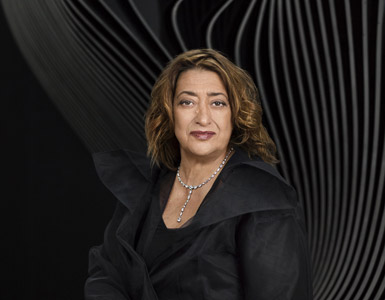
Zaha Hadid is the first woman to be awarded the Royal Gold Medal in her own right
The Royal Institute of British Architects (RIBA) has today (24 September 2015) announced that the globally-renowned architect Dame Zaha Hadid will receive the 2016 Royal Gold Medal, the first woman to be awarded the prestigious honour in her own right.
Given in recognition of a lifetime’s work, the Royal Gold Medal is approved personally by Her Majesty The Queen and is given to a person or group of people who have had a significant influence “either directly or indirectly on the advancement of architecture”. Awarded since 1848, past Royal Gold Medallists include Frank Gehry (2000), Norman Foster (1983), Ludwig Mies van der Rohe (1959), Le Corbusier (1953), Frank Lloyd Wright (1941) and George Gilbert Scott (1859).
Zaha Hadid is internationally known for her built, theoretical and academic work. Each of her dynamic and innovative projects builds on over thirty years of revolutionary experimentation and research in the fields of architecture, design and urbanism.
RIBA President and chair of the selection committee, Jane Duncan, said: “Zaha Hadid is a formidable and globally-influential force in architecture. Highly experimental, rigorous and exacting, her work from buildings to furniture, footwear and cars, is quite rightly revered and desired by brands and people all around the world. I am delighted Zaha will be awarded the Royal Gold Medal in 2016 and can’t wait to see what she and her practice will do next.”
Zaha Hadid said: “I am very proud to be awarded the Royal Gold Medal, in particular, to be the first woman to receive the honour in her own right. I would like to thank Peter Cook, Louisa Hutton and David Chipperfield for the nomination and Jane Duncan and the Honours Committee for their support. We now see more established female architects all the time. That doesn’t mean it’s easy. Sometimes the challenges are immense. There has been tremendous change over recent years and we will continue this progress. This recognition is an honour for me and my practice, but equally, for all our clients. It is always exciting to collaborate with those who have great civic pride and vision. Part of architecture’s job is to make people feel good in the spaces where we live, go to school or where we work – so we must be committed to raising standards. Housing, schools and other vital public buildings have always been based on the concept of minimal existence – that shouldn’t be the case today. Architects now have the skills and tools to address these critical issues.”
In a separate related incident Zaha Hadid called an interview with the BBC’s Today programme to a halt after an argument with presenter Sarah Montague.
Hadid was speaking on the BBC Radio 4 current affairs show following the Royal Gold Medal for Architecture announcement. But the interview developed into a row after Montague brought up reports of deaths among migrant workers on projects in Qatar.
The architect spoke about whether or not she found it harder to win the acceptance of the British establishment because people were “scared” of her. Asked about “the Qatar stadium, where there have been considerable problems – not least the number of deaths”, Hadid said: “There haven’t been any problems actually, sorry to put you right, there hasn’t been a single problem at our site in Qatar.”
Montague pointed to reports of 1,200 migrant deaths in the country – which in fact don’t relate specifically to the World Cup stadium projects – and Hadid said: “That is absolutely inaccurate, absolutely untrue. There have been no deaths on our site whatsoever.
“You should check your information before you say anything. I’ve sued someone before [for saying that] and they had to withdraw it and apologise. You should check your facts.” When Montague suggested that widespread reports of migrant deaths in Qatar might extend to workers on Hadid’s own Qatar World Cup Stadium site, the tone of the interview changed.
Moving on to reports that Hadid had pulled out of bidding to design the Tokyo 2020 Olympics stadium, the architect said it was an “important story” and should be reported correctly.
